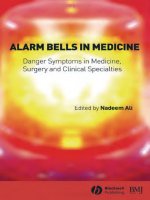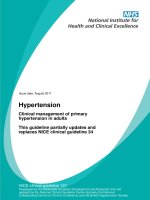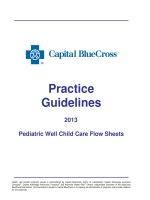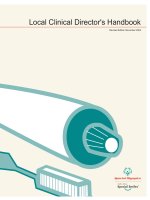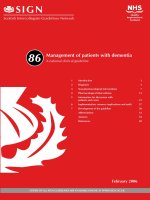Clinical pediatric neurology
Bạn đang xem bản rút gọn của tài liệu. Xem và tải ngay bản đầy đủ của tài liệu tại đây (10.02 MB, 641 trang )
Clinical Pediatric Neurology
Clinical Pediatric Neurology
Edited by
Ronald B. David, MD
Attending Physician
Department of Pediatrics
St. Mary’s Hospital
Associate Clinical Professor
Department of Pediatrics
Virginia Commonwealth University School of Medicine
Richmond, Virginia
With Section Editors
John B. Bodensteiner, MD
William Pilcher Chair of Pediatric Neurology
Barrow Neurologic Institute of St. Joseph’s Hospital and Medical Center
Phoenix, Arizona
David E. Mandelbaum, MD, PhD
Professor
Department of Clinical Neurosciences and Pediatrics
Alpert Medical School of Brown University
Providence, Rhode Island
Barbara J. Olson, MD
Private Practice
Pediatric Neurology Associates
Assistant Clinical Professor
Department of Pediatrics and Neurology
Vanderbilt University
Nashville, Tennessee
New York
Acquisitions Editor: Beth Barry
Cover Design: Steve Pisano
Copyeditor: Joann Woy
Compositor: Patricia Wallenburg
Printer: Bang Printing
Visit our website at www.demosmedpub.com
© 2009 Demos Medical Publishing, LLC. All rights reserved. This book is protected by copyright. No part of it may be reproduced,
stored in a retrieval system, or transmitted in any form or by any means, electronic, mechanical, photocopying, recording, or otherwise, without the prior written permission of the publisher.
Medicine is an ever-changing science. Research and clinical experience are continually expanding our knowledge, in particular our
understanding of proper treatment and drug therapy. The authors, editors, and publisher have made every effort to ensure that all
information in this book is in accordance with the state of knowledge at the time of production of the book. Nevertheless, the authors, editors, and publisher are not responsible for errors or omissions or for any consequences from application of the information in this book and make no warranty, express or implied, with respect to the contents of the publication. Every reader should
examine carefully the package inserts accompanying each drug and should carefully check whether the dosage schedules mentioned
therein or the contraindications stated by the manufacturer differ from the statements made in this book. Such examination is particularly important with drugs that are either rarely used or have been newly released on the market.
Library of Congress Cataloging-in-Publication Data
Clinical pediatric neurology / edited by Ronald B. David. — 3rd ed.
p. ; cm.
Rev. ed. of: Child and adolescent neurology / edited by Ronald B. David. 2nd ed. 2005.
Includes bibliographical references and index.
ISBN-13: 978-1-933864-22-8 (hardcover : alk. paper)
ISBN-10: 1-933864-22-2 (hardcover : alk. paper)
1. Pediatric neurology. I. David, Ronald B. II. Child and adolescent neurology.
[DNLM: 1. Nervous System Diseases—diagnosis. 2. Adolescent. 3. Child. 4. Diagnostic Techniques, Neurological. 5. Infant.
6. Nervous System Diseases—therapy. 7. Neurologic Examination. WS 340 C6415 2009]
RJ486.5.C45 2009
618.92'8—dc22
2008047998
Special discounts on bulk quantities of Demos Medical Publishing books are available to corporations, professional associations,
pharmaceutical companies, health care organizations, and other qualifying groups. For details, please contact:
Special Sales Department
Demos Medical Publishing
386 Park Avenue South, Suite 301
New York, NY 10016
Phone: 800–532–8663 or 212–683–0072
Fax: 212–683–0118
Email:
Made in the United States of America
09 10 11 12
5 4 3 2 1
To my children and grandchildren.
To all children . . . but particularly
To the children for whom we care . . .
those whose lives have been touched by the
misfortune of neurologic disorders.
Contents
Preface
Contributors
xi
xiii
I Pediatric Neurologic Evaluation
John B. Bodensteiner, Editor
1. Neurologic History
John B. Bodensteiner and Ronald B. David
3
2. The Neurologic Examination of the Preterm and Full-term Neonate and of the Infant
Patricia H. Ellison and Donna Kathryn Daily
17
3. The Neurologic Examination of the Young Child
Ruth D. Nass
45
4. The Neurologic Examination of the School-age and Adolescent Child
Ruthmary K. Deuel and Amy C. Rauchway
57
5. The Electroencephalogram
Warren T. Blume
65
6. Electrodiagnostic Evaluation of Pediatric Neuromuscular Disease
Laurie Gutmann and Jack E. Riggs
81
7. Clinical Evaluation with Evoked Responses
John F. Kerrigan
87
8. Neuroimaging Techniques
Russell J. Butterfield, Gary Hedlund, and James F. Bale, Jr.
99
II General Pediatric Neurologic Diseases and Disorders
David E. Mandelbaum, Editor
9. Toxic and Metabolic Encephalopathies
Michael Flink and Doris A. Trauner
117
vii
viii
Contents
10. Traumatic Encephalopathies
H. Terry Hutchison and Paul C. Lebby
129
11. The Epilepsies
Carl E. Stafstrom
151
12. Movement Disorders in Childhood
Kenneth J. Mack
189
13. Infections of the Central Nervous System
Amisha Malhotra, William E. Bell, and Frederick W. Henderson
211
14. Vascular Disease in Infants and Children
Richard H. Haas and Jennifer Armstrong-Wells
237
15. Inborn Errors of Metabolism I: Neurologic Degenerative Diseases
Paul Maertens
263
16. Inborn Errors of Metabolism II: Disorders of Purine and Amino Acid Metabolism
William L. Nyhan
337
17. Neoplastic Diseases
Roger J. Packer, Tobey J. MacDonald, Brian R. Rood, Gilbert Vezina, and Robert A. Keating
355
18. Neuromuscular Disease in Children
John T. Sladky
385
19. Order of Nervous System Development
Emanuel DiCicco-Bloom
403
20. Disorders of Nervous System Development: Cellular and Molecular Mechanisms
John N. Gaitanis and David E. Mandelbaum
415
21. Disorders of Motor Execution I: Cerebral Palsy
Barry S. Russman
433
22. Disorders of Motor Execution II: Higher-order Motor Deficits
Ruthmary K. Deuel and Amy C. Rauchway
451
23. Disorders of Cognitive Function in the Preschooler
Ruth D. Nass and Gail Ross
459
24. Learning Disabilities
Max Wiznitzer and Debora L. Scheffel
479
III Common Pediatric Neurologic Problems
Barbara J. Olson, Editor
25. Coma and Other States of Altered Awareness in Children
Stavros M. Hadjiloizou and James J. Riviello, Jr.
495
26. Headaches
Andrew D. Hershey
507
27. Febrile Seizures
Deborah G. Hirtz and Karin B. Nelson
517
Contents
ix
28. The Child with Attention Deficit Hyperactivity Disorder
Kevin M. Antshel, Michelle M. Macias, and Russell A. Barkley
525
29. Sleep Disorders
O’Neill F. D’Cruz and Bradley V. Vaughn
541
Appendix: A Proposed Approach to Nosology
549
Bibliography
557
Index
603
Preface
Traditional textbooks convey knowledge. It is the goal of
this text to convey not only essential knowledge but also
the collected wisdom of its many highly regarded contributors. To achieve the goal of conveying not only
knowledge but wisdom, each book in this series is built
on a structural framework that was well received by critics and readers alike in previous editions. Our text is divided into three sections:
•
•
•
Tools for diagnosis
Diseases and disorders
Common problems
Also included to facilitate a physician’s use of this
book are:
•
•
•
•
•
•
Nosologic diagnosis tables,
“Pearls and Perils” boxes,
“Consider Consultation When…” boxes,
Selected annotated bibliographies,
A complete bibliography,
And (new in this edition) Key Clinical
Questions.
The Nosologic Diagnosis tables are based on a discriminator model to promote clearer understanding and
are superior to a criterion-based model and others that
lack similar specificity. (See the Appendix for complete
description of how this system was developed.)
Whoever having undertaken to speak or write
hath first laid for themselves some [basis] to
their argument such as hot or cold or moist or
dry or whatever else they choose, thus reducing their subject within a narrow compass.
Hippocrates
As Hippocrates has suggested, structure is the key to
learning. Unless there is a structure onto which knowledge can be built, confusion and disorganization are the
inevitable consequences.
Classification systems induce orderliness in thinking and enhance our ability to communicate effectively.
A review of the most enduring hierarchical classification
systems, particularly that of Linnaeus (that is, phyla, genera, species), makes clear the value of grouping according
to discriminating features, as well as the value of simplicity, expandability, and dynamism.
The goal, whatever the classification system, is to
seek the most powerful discriminating features that will
produce the greatest diagnostic clarity. Discriminating features should avoid crossing domains. Much of the confusion that arises in diagnosis may be the result of the
clinician who unwittingly crosses the anatomic, pathologic,
pathophysiologic, phenomenologic, and etiologic classification domains used in medicine (for example, the inclusion of anatomically oriented “temporal lobe seizures” in
a phenomenologically based classification system that includes complex partial seizures). Some conditions, such as
brain tumors, are classified according to their histopathology and lend themselves well to this classification system.
Others, such as headaches and movement disorders, are
classified phenomenologically and are therefore much less
easily classified. In other cases, discriminators must encompass inclusionary as well as exclusionary features. At
times, we can only use a criterion-based system or construct tables to compare features.
Arbitrarily, we label as consistent those features that
occur more than 75% of the time; features are considered
variable when they occur less than 75% of the time. The
diagnostic tables should be viewed, therefore, only as a
beginning in the extremely difficult effort to make diagnosis more precise and biologically based. How well this
book accomplishes the goals of identifying the most powxi
xii
Preface
erful discrimination features for maximum diagnostic
clarity is limited by the current state of the art in child
and adolescent neurology. In some areas, several features,
when clustered together, serve to discriminate.
This text is designed to be pithy, not exhaustive,
many other books of that ilk are already available. Each
text in this series reflects appropriate stylistic differences
among content editors. However, each is built upon the
same structural framework; hence the value of this text
to the users.
Chapter 16 on “Order and Disorders of Nervous
System Development” is particularly noteworthy because
of its unique treatment of this very important and timely
subject matter.
Acknowledgment
I would like to acknowledge some of the people who have
made key contributions to this effort. They include Craig
Percy, who initially saw the potential of this effort and
headed the team at Demos; the National Institute of Neu-
*NINDS 1PO1NS20189–01A1 (Nosology, Higher Cortical Function
Disorders in Children).
rological Disorders and Stroke (NINDS)* for its support
in nosologic research; and the investigators who were involved with this NINDS project; Dr. Grover Robinson, a
long-time friend (who suggested the “Consider Consultation When…” boxes); and Ms. Laura DeYoung a longtime publishing friend. I am also particularly grateful to
my associate editor colleagues, Drs. John Bodensteiner,
David Mandelbaum, and Barbara Olson, for their extensive and hands-on contribution to this edition. Their help
is reflected, I feel, in the extraordinary quality of the present effort. Lastly, I would thank Dr. Susan Pillsbury, a
close friend and trusted colleague, whose advice is always
cogent and whose personal support is most appreciated.
This text is therefore in no way a singular effort but
rather reflects the expertise of all who contributed in so
many different ways. It is my hope that this is reflected in
the quality of the effort. It is therefore my fondest wish
that this text resides on your desk, rather than on your
bookshelf.
Ronald B. David, MD
Contributors
Kevin M. Antshel, PhD
John B. Bodensteiner, MD
Assistant Professor of Psychiatry
Department of Psychiatry and Behavioral Sciences
State University of New York Upstate Medical University
Syracuse, New York
William Pilcher Chair of Pediatric Neurology
Barrow Neurologic Institute of St. Joseph’s Hospital
and Medical Center
Phoenix, Arizona
Jennifer Armstrong-Wells, MD, MPH
Russell J. Butterfield, MD, PhD
Resident Physician
Department of Neurology
University of California San Francisco
San Francisco, California
Fellow
Department of Neurology
University of Utah School of Medicine
Salt Lake City, Utah
James F. Bale, Jr., MD
Donna Kathryn Daily, MD, MA
Professor and Associate Chair
Department of Pediatrics
University of Utah School of Medicine
Salt Lake City, Utah
Associate Professor of Pediatrics
Department of Pediatrics
Vanderbilt University Medical School
Nashville, Tennessee
Russell A. Barkley, PhD
Ronald B. David, MD
Clinical Professor of Psychiatry
Department of Psychiatry
Medical University of South Carolina
Charleston, South Carolina
Attending Physician
Department of Pediatrics
St. Mary’s Hospital
Associate Clinical Professor
Department of Pediatrics
Virginia Commonwealth University School of Medicine
Richmond, Virginia
William E. Bell, MD
Professor Emeritus
Department of Pediatrics and Neurology
The University of Iowa Hospitals
Iowa City, Iowa
Warren T. Blume, MD, CM, FRCP(C)
Professor of Neurology and Pediatrics
Department of Neurology
University Hospital
University of Western Ontario
London, Ontario
Canada
O’Neill F. D’Cruz, MD, MBA
Clinical Research Physician
Department of Clinical Science
Actelion Parmaceuticals Ltd.
Cherry Hill, New Jersey
xiii
xiv
Contributors
Ruthmary K. Deuel, MD
Gary Hedlund, DO
Professor Emeritus
Department of Pediatrics and Neurology
Washington University School of Medicine
St. Louis, Missouri
Adjunct Professor Radiology
Department of Medical Imaging
University of Utah School of Medicine
Salt Lake City, Utah
Emanuel DiCicco-Bloom, MD
Frederick W. Henderson, MD
Professor
Departments of Neuroscience and Cell Biology and
Pediatrics (Neurology)
Robert Wood Johnson School of Medicine
Piscataway, New Jersey
Distinguished Professor of Pediatrics
Department of Pediatrics
University of North Carolina
Chapel Hill, North Carolina
Andrew D. Hershey, MD, PhD, FAHS
Patricia H. Ellison, MD
Adjunct Professor, Retired
Department of Pediatrics
University of Colorado School of Medicine
Denver, Colorado
Professor of Pediatrics and Neurology
Department of Pediatrics
Cincinnati Children’s Hospital Medical Center
University of Cincinnati College of Medicine
Cincinnati, Ohio
Michael Flink, DO, PhD
Deborah G. Hirtz, MD
Assistant Professor
Department of Neurosciences
University of California San Diego School of Medicine
La Jolla, California
Program Director
Office of Clinical Trials
National Institute of Neurological Disorders and Stroke
National Institutes of Health
Rockville, Maryland
John N. Gaitanis, MD
Assistant Professor of Clinical Neurosciences and
Pediatrics
Department of Neurology
Warren Alpert School of Medicine at Brown University
Providence, Rhode Island
H. Terry Hutchinson, MD, PhD
Laurie Gutmann, MD
Robert A Keating, MD
Professor of Neurology and Exercise Physiology
Department of Neurology
West Virginia University
Morgantown, West Virginia
Chief
Department of Pediatric Neurosurgery
Children’s National Medical Center
Professor
Department of Neurosurgery
The George Washington University
Washington, DC
Richard H. Haas, MB, B Chir
Professor
Department of Neurosciences and Pediatrics
University of California San Diego
La Jolla, California
Stavros M. Hadjiloizou, MD
Child Neurologist
Department of Epilepsy and Clinical Neurophysiology
Cyprus Paediatric Neurology Institute
The Cyprus Institute of Neurology and Genetics
Nicosia, Cyprus
Clinical Professor
Department of Child Neurology
University of California San Francisco
San Francisco, California
John F. Kerrigan, MD
Director
Pediatric Epilepsy Program
Co-Director
Hypothalamic Hamartoma Program
Barrow Neurologic Institute of St. Joseph’s Hospital
and Medical Center
Assistant Professor
Department of Clinical Pediatrics and Neurology
University of Arizona College of Medicine Phoenix
Phoenix, Arizona
Contributors
xv
Paul C. Lebby, PhD
Karin B. Nelson, MD
Clinical Neuropsychologist
Department of Neuropsychology and
Medical Rehabilitation
Children’s Hospital Central California
Madera, California
Scientist Emeritus
National Institute of Neurological Disorders and Stroke
National Institutes of Health
Bethesda, Maryland
William L. Nyhan, MD, PhD
Tobey J. MacDonald, MD
Director
Department of Hematology/Oncology
Center for Cancer and Blood Disorders
Children’s National Medical Center
Associate Professor
Department of Neurology and Pediatrics
The George Washington University
Washington, DC
Michelle M. Macias, MD
Associate Professor of Pediatrics
Department of Pediatrics
Medical University of South Carolina
Charleston, South Carolina
Kenneth J. Mack, MD, PhD
Medical Director
Departments of Neurology and Pediatrics
Mayo Clinic Pediatric Center
Rochester, Minnesota
Paul Maertens, MD
Associate Professor Child Neurology
Department of Neurology and Pediatrics
University of South Alabama
Mobile, Alabama
Amisha Malhotra, MD
Assistant Professor of Pediatrics
Department of Pediatrics
Robert Wood Johnson School of Medicine
University of Medicine and Dentistry of New Jersey
New Brunswick, New Jersey
Professor of Pediatrics
Department of Pediatrics
University of California San Diego
San Diego, California
Barbara J. Olson, MD
Private Practice
Pediatric Neurology Associates
Assistant Clinical Professor
Department of Pediatrics and Neurology
Vanderbilt University
Nashville, Tennessee
Roger J. Packer, MD
Executive Director
Department of Neuroscience and Behavioral Medicine
Director
Brain Tumor Institute
Children’s National Medical Center
Professor
Department of Neurology and Pediatrics
The George Washington University
Washington, DC
Amy C. Rauchway, DO
Assistant Professor of Neurology
Departments of Neurology and Psychiatry
Saint Louis University School of Medicine
St. Louis, Missouri
Jack E. Riggs, MD
Professor of Neurology
Department of Neurology
West Virginia University
Morgantown, West Virginia
David E. Mandelbaum, MD, PhD
Professor
Department of Clinical Neurosciences and Pediatrics
Alpert Medical School of Brown University
Providence, Rhode Island
Ruth D. Nass, MD
Professor of Clinical Neurology (Pediatrics)
Department of Neurology
New York University School of Medicine
New York, New York
James J. Riviello, Jr., MD
George Peterkin Endowed Chair in Pediatrics
Professor of Pediatrics and Neurology/Neurophysiology
Departments of Pediatrics and Neurology
Texas Children’s Hospital
Houston, Texas
xvi
Contributors
Brian R. Rood, MD
Carl E. Stafstrom, MD, PhD
Attending Physician
Department of Hematology/Oncology
Children’s National Medical Center
Assistant Professor
Department of Pediatrics
The George Washington University
Washington, DC
Professor of Neurology and Pediatrics
Department of Neurology
University of Wisconsin
Madison, Wisconsin
Gail Ross, PhD
Associate Professor of Psychology
Departments of Pediatrics and Psychiatry
Weill Medical Center of Cornell University
New York, New York
Barry S. Russman, MD
Professor Pediatrics and Neurology
Oregon Health & Science University
Portland, Oregon
Doris A. Trauner, MD
Professor and Chief, Pediatric Neurology
Department of Neurosciences and Pediatrics
Rady Children’s Hospital
University of California San Diego School of Medicine
La Jolla, California
Bradley V. Vaughn, MD
Professor of Neurology and Biomedical Engineering
Department of Neurology
University of North Carolina
Chapel Hill, North Carolina
Gilbert Vezina, MD
Debora L. Scheffel, PhD
Academic Dean
Jones International University
Centennial, Colorado
John T. Sladky, MD
Chief
Department of Pediatric Neurology
Children’s Healthcare of Atlanta at Egleston
Chief
Department of Pediatric Neurology
Emory University School of Medicine
Atlanta, Georgia
Chief
Department of Neuroradiology
Children’s National Medical Center
Professor
Department of Radiology
The George Washington University
Washington, DC
Max Wiznitzer, MD
Division Of Pediatric Neurology
Rainbow Babies & Children’s Hospital
Associate Professor of Pediatrics and Neurology
Case Western Reserve University
Cleveland, Ohio
Clinical Pediatric Neurology
SECTION
1
PEDIATRIC NEUROLOGIC
EVALUATION
John B. Bodensteiner
CHAPTER
1
Neurologic History
John B. Bodensteiner and Ronald B. David
Some clinicians have suggested that the taking of the neurologic history is as important as, or potentially more important than, the neurologic examination itself. Other
clinicians have suggested that the neurologic history identifies the nature of the disorder or disease, and the neurologic examination confirms or pinpoints its location.
The history itself may be a narrative recapitulation of information provided by a child’s primary caregiver(s), or it
may be generated in response to a questionnaire or checklist. Experienced clinicians realize that the key to making
a successful diagnosis often lies in asking the right questions and listening carefully to the answers. Responses to
questionnaires or checklists can be used as part of a formal structured interview. Diagnostically, they can be both
reliable and valid. For example, a patient may be asked
the following questions with respect to headaches: Are
your headaches confined to one side of your head? Are
your headaches associated with vomiting or a desire to
sleep? Do you have visual symptoms, such as dancing
lights or other phenomena? An affirmative response to all
three questions would permit accuracy of close to 100%
for the diagnosis of migraine. No other questions or laboratory investigations may be necessary. Other questions
provide clinical rather than diagnostic information, useful in practicing the art as well as the science of medicine.
The reliability of the information gained from a
questionnaire depends to some extent on the ability of the
respondent to understand the questions being asked. The
questions that follow are those used by many clinicians to
accomplish this end. Some are also valuable in answering
research questions. They are all designed to be useful in
the practice of pediatric neurology. Note: This form may
be reproduced for clinical use without further permission
from the author or publisher. In order to make the questions more useful, we have collected them into groups
based on the three most common presenting complaints
in the pediatric neurology outpatient setting, namely
seizures, headache, and developmental delay. This is not
a copyrighted section of this text and clinicians should
feel free to lift any or all questions or formats for reproduction and clinical use.
▼
Pearls and Perils
The diagnosis can often be determined or inferred from
one or two key questions.
Willingness to comply with treatment can be probed by
use of key questions.
Willingness to accept diagnosis can be probed through
key questions.
3
4
Section 1
▼
Pediatric Neurologic Evaluation
A. Demographic data
1.
2.
3.
4.
5.
6.
7.
8.
9.
10.
11.
12.
Name __________________________________________________________________________________________
Child’s date of birth ______________ /______________ /______________
Child’s age ______________ /______________
Child’s sex
a.
Male
______________
b.
Female
______________
Child’s race
a.
Caucasian
______________
b.
African American
______________
c.
Latino
______________
d.
Asian
______________
e.
Other
______________
Birthplace _______________________________________________________________________________________
Name of hospital_________________________________________________________________________________
Child’s siblings (please list oldest first)
Age
Sex
Relation to this child
Initials
Years
Months
M
F
Full
Half
Adopted
Step
________________________________________________________________________________________________
________________________________________________________________________________________________
________________________________________________________________________________________________
________________________________________________________________________________________________
________________________________________________________________________________________________
Marital status of parents
a.
Married
______________
b.
Single
______________
c.
Separated
______________
d.
Divorced
______________
Relationship of caregiver to child
a.
Natural parent
______________
b.
Adoptive parent
______________
c.
Stepparent
______________
d.
Foster parent
______________
e.
Grandparent
______________
f.
Aunt or uncle
______________
g.
Brother or sister
______________
h.
Other
______________
Parents’ educational experience
Father
Mother
a.
Eighth grade or less
______________
______________
b.
Attended high school
______________
______________
c.
High school graduate
______________
______________
d.
Attended college
______________
______________
e.
Two-year degree
______________
______________
f.
Four-year degree
______________
______________
g.
Master’s degree
______________
______________
h.
Doctorate
______________
______________
Handedness of parents
Father
Mother
a.
Right
______________
______________
b.
Left
______________
______________
c.
Ambidextrous
______________
______________
Chapter 1
13.
▼
Neurologic History
5
Please check if the parent was or is considered to have difficulty with any of the following:
Father
Mother
a.
Speech
______________
______________
b.
Confusion of left and right hands
______________
______________
c.
Overactivity, restlessness, hyperactivity
______________
______________
d.
Being clumsy or awkward
______________
______________
e.
Walking
______________
______________
f.
Math
______________
______________
g.
Spelling
______________
______________
h.
Reading
______________
______________
i.
Delayed or unintelligible language
______________
______________
j.
Seizures or convulsions
______________
______________
k.
Nerves or nervous breakdown
______________
______________
l.
Mental retardation
______________
______________
B. Medical information/history
1.
2.
Please check if your child has ever experienced any of the following:
a.
More than two episodes of otitis media
b.
Tubes in ears (myringotomy)
c.
Visual difficulty requiring either glasses or visual training
d.
Hearing difficulty requiring the use of a hearing aid
e.
Movement problems requiring the use of special shoes, splints, braces,
or a wheelchair or a specialized program of motor training
f.
Failure to thrive
g.
Poisoning or drug overdose
h.
Eating unusual substances (e.g. paint, plaster)
i.
Unconscious spells, fainting
j.
Convulsions, seizures, epilepsy
k.
Bedwetting beyond the age of 5 years
l.
Soiling beyond the age of 3 years
m. Sleeping problems
n.
Poor growth or poor weight gain
o.
Unusual reactions to baby shots
p.
Toe walking
q.
Ran or walked more awkwardly than other children
r.
Ran or walked more slowly than other children
s.
Picked last or close to last in games where children pick sides
t.
Tics or unusual movements
u.
Headaches not relieved by nonprescription pain medicine
v.
Headaches not relieved by prescription pain medicine
w. Headaches occurring in the middle of the night or upon awakening
x.
Production of unusual odors
y.
Unusual habits
z.
Difficulty swallowing
aa. Excessive drooling
bb. Poor sucking or feeding as an infant
cc. Lost once-attained skills (speech, language, or motor)
dd. Seemed to be in a world of his own
ee. Had difficulty with taking turns
ff. Became upset if lined-up toys were disturbed
Has your child ever been diagnosed as
a.
Hyperactive (hyperkinetic)
b.
Brain-damaged
Yes
_________
_________
_________
_________
No
_________
_________
_________
_________
_________
_________
_________
_________
_________
_________
_________
_________
_________
_________
_________
_________
_________
_________
_________
_________
_________
_________
_________
_________
_________
_________
_________
_________
_________
_________
_________
_________
_________
_________
_________
_________
_________
_________
_________
_________
_________
_________
_________
_________
_________
_________
_________
_________
_________
_________
_________
_________
_________
_________
_________
_________
_________
_________
_________
_________
_________
_________
_________
_________
6
Section 1
3.
▼
Pediatric Neurologic Evaluation
c.
Retarded
d.
Developmentally delayed or disabled
e.
Having epileptic seizures (including febrile)
f.
Motor-delayed
g.
Cerebral-palsied
h.
Language-delayed
i.
Immature
j.
Hearing-impaired or deaf
k.
Blind or partially sighted
l.
Emotionally disturbed
m. Hypotonic
n.
Spastic
o.
Attention deficit-disordered
p.
Learning-disabled
q.
Autistic or demonstrating autistic-like behavior
Has your child ever
a.
Had a special diet
b.
Received speech therapy
c.
Attended a preschool special education program
d.
Received counseling (family or individual)
e.
Received special education services, grades K through 12
f.
Been hospitalized
g.
Been suspended or discharged from day care, kindergarten or school
Yes
_________
_________
_________
_________
_________
_________
_________
_________
_________
_________
_________
_________
_________
_________
_________
No
_________
_________
_________
_________
_________
_________
_________
_________
_________
_________
_________
_________
_________
_________
_________
_________
_________
_________
_________
_________
_________
_________
_________
_________
_________
_________
_________
_________
_________
_________
_________
_________
_________
_________
_________
_________
_________
_________
_________
_________
_________
_________
_________
_________
_________
_________
_________
_________
_________
_________
_________
_________
_________
_________
_________
_________
_________
_________
_________
_________
_________
_________
_________
_________
_________
_________
_________
_________
_________
_________
_________
_________
_________
_________
_________
_________
_________
_________
_________
C. Treatment information
1.
2.
Has your child ever been evaluated by a
a.
(1) Neurologist (child or general)
(2) Pediatrician
(3) Family doctor
(4) Psychiatrist
(5) Physiatrist (physical medicine or rehabilitation specialist)
b.
School psychologist
c.
Teacher
d.
Special education placement committee
e.
Child development specialist
f.
Physical or occupational therapist
g.
Speech/language pathologist
Has your child ever taken
a.
Phenobarbital
b.
Dilantin (phenytoin)
c.
Mysoline (primidone)
d.
Depakene, Depakote (valproic acid)
e.
Tegretol (carbamazepine)
f.
Zarontin (ethosuximide)
g.
Valium (diazepam)
h.
Haldol (haloperidol)
i.
Klonopin or Clonopin (clonazepam)
j.
Neurontin (gabapentin)
k.
Felbatol (felbamate)
l.
Lamictal (lamotrigine)
m. Trileptal (oxcarbazepine)
n.
Zonegran (zonisamide)
